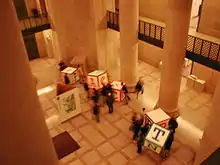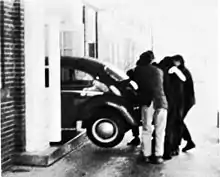Practical joke
A practical joke, or prank, is a mischievous trick played on someone, generally causing the victim to experience embarrassment, perplexity, confusion, or discomfort.[1][2] A person who performs a practical joke is called a "practical joker" or "prankster".[1] Other terms for practical jokes include gag, rib, jape, or shenanigan.

Practical jokes differ from confidence tricks or hoaxes in that the victim finds out, or is let in on the joke, rather than being talked into handing over money or other valuables. Practical jokes are generally lighthearted and without lasting effect; they aim to make the victim feel humbled or foolish, but not victimized or humiliated. Thus most practical jokes are affectionate gestures of humour and designed to encourage laughter. However, practical jokes performed with cruelty can constitute bullying, whose intent is to harass or exclude rather than reinforce social bonds through ritual humbling.[3]
Some countries in Western culture traditionally emphasize the carrying out of practical jokes on April Fools' Day.[4]
Description
A practical joke is "practical" because it consists of someone doing something that is physical, in contrast to a verbal or written joke. For example, the joker who is setting up and conducting the practical joke might hang a bucket of water above a doorway and rig the bucket using pulleys so when the door opens the bucket dumps the water. The joker would then wait for the victim to walk through the doorway and be drenched by the bucket of water. Objects can feature in practical jokes, like fake vomit, chewing-gum bugs, exploding cigars, stink bombs, costumes, whoopee cushions, and Chinese finger traps. A practical joke can be as long as a person desires. It does not have to be short-lived.
Practical jokes often occur in offices, usually to surprise co-workers. Examples include covering computer accessories with Jell-O, wrapping a desk with Christmas paper or aluminium foil or filling it with balloons.[5] Practical jokes also commonly occur during sleepovers, when teens play pranks on their friends as they come into the home, enter a room or even as they sleep.
American humorist H. Allen Smith wrote a 320-page book in 1953 called The Compleat Practical Joker[6] that contains numerous examples of practical jokes. The book became a best seller - not only in the United States but also in Japan.[7] Moira Marsh has written an entire volume about practical jokes.[2] - she found that in the USA males perpetrate such gags more often than females.
Famous examples
One practical joke - recalled as his favorite by the playwright Charles MacArthur - concerns the American painter and bohemian character Waldo Peirce. While living in Paris in the 1920s, Peirce "made a gift of a very big turtle to the woman who was the concierge of his building". The woman doted on the turtle and lavished care on it. A few days later Peirce substituted a somewhat larger turtle for the original one. This continued for some time, with the surreptitious introduction of larger and larger turtles into the woman's apartment. The concierge, beside herself with happiness, displayed her miraculous turtle to the entire neighborhood. Peirce then began to sneak in and replace the turtle with smaller and smaller ones, to her bewildered distress.[8] This prank became the storyline behind Roald Dahl's 1990 novel Esio Trot.


Successful modern pranks often take advantage of the modernization of tools and techniques. In Canada, engineering students have a reputation for annual pranks; at the University of British Columbia these usually involve leaving a Volkswagen Beetle in an unexpected location (such as suspended from the Golden Gate Bridge[9] or from the Lions Gate Bridge[10]). Engineering students at Cambridge University in England undertook a similar prank, placing an Austin 7 car on top of the University's Senate House building.[11] Pranks can also adapt to the political context of their era.[12] Students at the Massachusetts Institute of Technology (MIT) have a particular reputation for their "hacks".[13]
Not unlike the stone louse of Germany, the jackalope in the American West has become an institutionalized practical joke perennially perpetrated by ruralites (as a class) on tourists, most of whom have never heard of the decades-old myth.[14]
The 2003 TV movie Windy City Heat consists of an elaborate practical joke on the film's star, Perry Caravallo, who is led to believe that he is starring in a faux action film, Windy City Heat, where the filming (which is ostensibly for the film's DVD extras) actually documents a long chain of pranks and jokes performed at Caravallo's expense.[15]
In the UK, a group that calls itself Trollstation, plays pranks on people including police officers and government employees. They record their escapades and upload them to Youtube. In one such video, one of the groups actors poses as a palace guard. Some of actors have been fined or charged. [16]
See also
References
- "Practical joke". Dictionary.com. Retrieved 2012-05-27.
- Marsh, Moira. 2015. Practically Joking. Logan: Utah State University Press. ISBN 978-0-87421-983-8
- Kádár, Dániel Z. (2013). Relational Rituals and Communication: Ritual Interaction in Groups. p. 156. ISBN 978-0230393059.
- "Japes of the great (book review of April is the cruellest month: The history and meaning of All Fools' Day)". The Economist. April 2, 1988. Retrieved 2011-04-18.
- "Funny Office Pranks". Weirdomatic.com. Retrieved 2012-10-25.
- Smith, Harry Allen (1953). The Compleat Practical Joker. ISBN 0-688-03705-4.
-
Publishers Weekly. 209. 1976. p. 2:24 https://books.google.com/books?id=jAtFAQAAIAAJ. Missing or empty
|title=(help) - Fun Fare: a Treasury of Reader's Digest Wit and Humor. 1949. p. 36.
- Curiel, Jonathan. "Beetle Overboard! / VW hung off GG Bridge in prank", San Francisco Chronicle, February 5, 2001, accessed March 9, 2011
- "The Golden Gate prank by UBC engineering students may have been the best ever - Macleans.ca". www.macleans.ca. Retrieved 2020-10-08.
- From Hermes to bonsai kittens. What makes a jape great?, from The Economist, December 20, 2005. Discusses the origins and evolution of pranks.
- Priceless pranks, from The Economist, February 21, 2006. Lists famous and successful pranks throughout history.
- Kravets, David. "April 1, 1998: Disney to Buy MIT for $6.9 Billion" Wired, March 31, 2010, accessed March 10, 2011.
- Deutsch, James (2014). "Jackalope". In Levine, Timothy R. (ed.). Encyclopedia of Deception. p. 555. ISBN 978-1483306896.
- Hyden, Steven (2013-11-12). "The Greatest Trick Comedy Ever Pulled". Grantland. Retrieved 2015-01-23.
- https://www.bbc.com/news/technology-36305727
External links
| Look up prank in Wiktionary, the free dictionary. |
| Wikimedia Commons has media related to Pranks. |